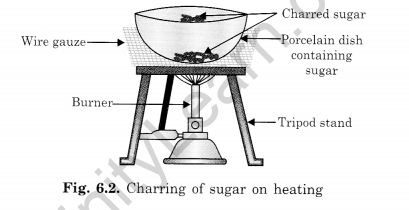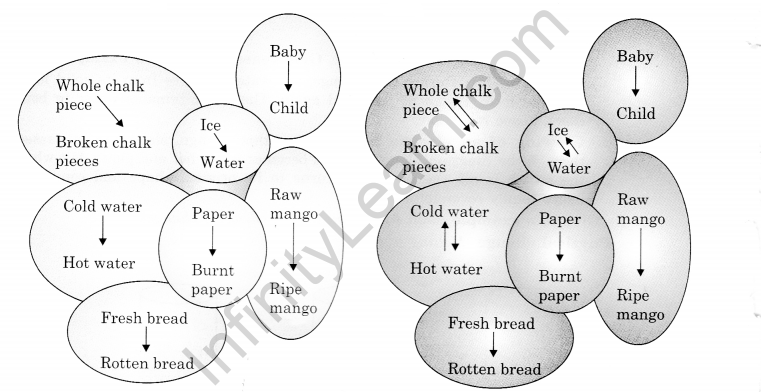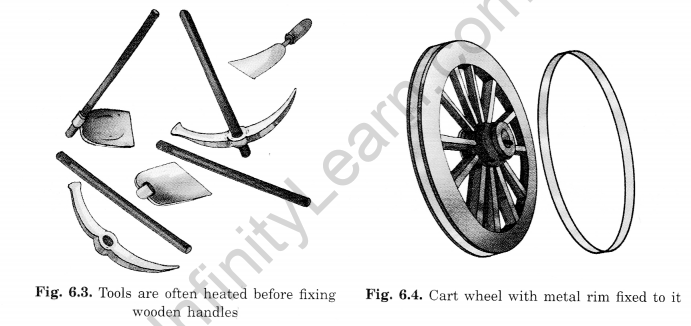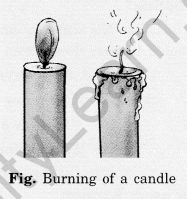Changes Around Us Class 6 Extra Questions Science Chapter 6
NCERT Extra Questions for Class 6 Science Chapter 6 Changes Around Us
Can all changes always be reversed?
Question 1.
What are reversible and irreversible changes?
Answer:
Reversible and irreversible changes:
Reversible changes: The changes which can be brought back to its original form are known as reversible changes. For example, melting of wax and stretching of a rubber band.
Irreversible changes: The changes in which the matter cannot be brought back to its original state are known as irreversible changes. For example, burning of paper changes it into ash and smoke. Paper cannot be obtained back from ash and smoke.
Question 2.
What are the differences between reversible changes and irreversible changes?
Answer:
The differences between reversible changes and irreversible changes:
| Reversible changes | Irreversible changes |
| 1. A change which can be undone or reversed.
2. It is a temporary change. 3. Melting and folding are examples of it. |
1. A change which cannot be undone or reversed.
2. It is a permanent change. 3. Burning and cooking of food are examples of it. |
Question 3.
Can you obtain wood from sawdust?
Answer:
No, because it is an irreversible change.
Question 4.
Can we say that ironing of a cloth is a reversible change? Give reasons.
Answer:
Ironing removes the wrinkles of the clothes, which can come back in the same condition. Hence, ironing of a cloth is a reversible change.
Question 5.
Can deforestation be considered as a reversible change?
Answer:
No, deforestation can’t be considered as a reversible change because no same tree can be planted after felling down or cutting.
Question 6.
Is printing a reversible or an irreversible change?
Answer:
Printing is an irreversible change because we cannot separate and collect the printing ink after printing.
Question 7.
Give two examples each of reversible and irreversible changes.
Answer:
Reversible changes: Melting of wax and stretching of a rubber band.
Irreversible changes: Burning of a paper and growth of plants.
Question 8.
State whether burning of a piece of paper is a reversible or an irreversible change.
Answer:
When we bum a piece of paper, it changes into ash and smoke. We cannot combine the ash and smoke to form the original piece of paper. So the burning of a piece of paper is an irreversible change.
Question 9.
Classify the following as reversible or irreversible changes:
(i) Growth of a plant
(ii) Ploughing a field,
(ii) Melting of wax
(iv) Falling of rain
(v) Pulling of rubber string
(vi) Breaking of a glass rod
(mi) Cooking of food.
Answer:
Reversible changes: (ii), (iii), (v)
Irreversible changes: (i), (iv), (vi), (vii).
Question 10.
How does curd set? Is this change reversible?
Answer:
A small quantity of curd is added to warm milk. The milk is stirred and is set aside undisturbed for a few hours at a warm place. In a few hours, the milk changes into curd.
Curd formed from milk cannot be changed into milk again. So, this is an irreversible change.
Question 11.
What are fast and slow changes?
Answer:
Fast changes take place over a short duration of time.
Slow changes take a longer duration of time to complete.
Question 12.
Define physical and chemical changes. Give examples.
Answer:
1. Physical change: Physical change is a temporary change in which chemical composition of the substance does not change and no new substance is formed.
During a physical change, only the physical properties of a substance change.
It is a reversible change. For example, melting of ice, during this change, the water changes from its solid form to liquid form. It can be solidified again.The water remains water in both the cases.
2. Chemical change: A chemical change is a permanent change in which not .
only the physical properties but chemical properties also change. It is an irreversible change. For example, formation of curd from milk, rusting of iron, etc.
Question 13.
Formation of clouds is a physical change. Explain.
Answer:
Formation of clouds is a physical change as it is phase transformation cycle of natural water from liquid to gas and then, gas to liquid. Hence, the property of water never changes in clouds form.
Question 14.
Explosion of a cracker is a chemical change. Explain.
Answer:
Explosion of crackers is a chemical change because the explosive reactants are transformed into gaseous products along with heat and light and thus cannot be reversed.
Hence, it is a chemical change.
Question 15.
Give some examples of physical and chemical changes.
Answer:
Examples of physical changes:
Tearing of sheet of paper into pieces, melting of ice, change of water into steam, breaking of glass tumbler, glowing of electric bulb, dissolution of sugar or salt in water.
Examples of chemical changes:
Burning of paper, wood, candle, etc., formation of curd from milk, cooking of food, rusting of iron and mixing of vinegar with baking soda, electrolysis of water.
Question 16.
Classify the following changes in as many ways as you can:
- Breaking of a brick with a hammer.
- Beating of heart.
- Germination of a seed.
- Burning of an incense-stick (agarbatti).
- Occurrence of solar eclipse.
Answer:
- Physical change, irreversible change.
- Periodic change, irreversible change.
- Irreversible change,
- Irreversible change, chemical change.
- Irreversible change.
Question 17.
Most physical changes are reversible. Give reasons with two examples.
Answer:
- Melting of ice: During this change, the water changes from its solid form to liquid form. It can be solidified again. The water remains water in both cases, hence reversible.
- Glowing of an electric bulb: During this change, electricity is passed through the tungston filament which becomes white hot and glows, but when the switch is off, the filament returns to its original shape and condition, hence totally reversible.
Question 18.
Give one example .each for physical and chemical changes
Answer:
Physical change (Melting of ice)

Question 19.
What is charring of sugar? Is it a chemical change?
Answer:
When sugar is continuously heated in the porcelain dish, it becomes foggy due to water vapour. A black powdery substance is left behind, which is charcoal. This process is also called charring of sugar and this is a chemical change.

Question 20.
Give some examples of changes which take place on their own.
Answer:

Question 21.
Give some examples of changes which take place on their own.
Answer:
Many changes are taking place around us on their own. For example:
- Ripening of crops in the fields.
- Leaves fall from trees.
- Flowers bloom and then wither away.
- Growing of hair and nail.
Could there be other ways to bring a change?
Question 1.
Does, like all other liquids, water expand on heating and contract on cooling?
Answer:
No, water is an exception. Water contracts on cooling till 4°C but expands when cooled further down from 4°C to 0°C.
Question 2.
List few ways to bring a change.
Answer:
- Heating or cooling
- Mixing two or more substances
- By applying force etc.
Question 3.
Give some examples from daily life where expansion of metal by heating is used. Explain.
Answer:
Fixing of a metal rim on an wooden wheel and fixing of wooden handles in iron blade in agricultural tools are such examples.
The iron blade of these tools has a ring in which the wooden handle is fixed. Normally, the ring is slightly smaller in size than the wooden handle. To fix the handle, the ring is heated and it becomes slightly larger in size (expands). Now, the handle easily fits into the ring. When the ring cools down, it contracts and fits tightly onto the handle.

Such a change is also used for fixing the metal rim on a wooden wheel of a«cart as shown in Fig. 6.4. Again the metal rim is made slightly smaller than the wooden wheel. On heating, the rim expands and fits onto the wheel. Cold water is then poured over the rim, which contracts and fits tightly onto the wheel.
Question 4.
Explain how a metal rim slightly smaller than a wooden wheel can be fixed on it.
Answer:
The metal rim is always made slightly smaller than the wooden wheel. The metal rim is heated; on heating, the rim expands and fits onto the wheel. Cold water is then poured over the rim. Due to cooling, rim contracts and fits tightly over the wheel.
Activity 7.
Take a small candle and measure its length with a scale. Now, fix it at a suitable place and light it. Let it burn for some time. Now blow out the candle and measure its length again (Fig.).
Its length will be reduced.
Can the change in the length of the candle be reversed? If we were to take some wax in a pan and heat it, can this change be reversed (Fig.)?


No, the change in the length of the candle cannot be reversed. Yes, on heating the wax in a pan, its change into liquid form can be reversed.
Objective Type Questions
Question 1.
Match the following items given in Column A with that in Column B:
| Column A | Column B |
| (a) Irreversible change (b) Reversible change (c) Sawing of a piece of wood (d) Ripening of mango (e) Melting of wax (f) Formation of a sugar solution |
(i) Needs mixing of two substances (ii) Needs heating (iii) Chemical change (iv) A new substance is formed (v) Physical change (vi) No new substance is formed |
Answer:
| Column A | Column B |
| (a) Irreversible change (b) Reversible change (c) Sawing of a piece of wood (d) Ripening of mango (e) Melting of wax (f) Formation of a sugar solution |
(vi) No new substance is formed (iv) A new substance is formed (v) Physical change (i) Needs mixing of two substances (ii) Needs heating (iii) Chemical change |
Question 2.
Fill in the blanks with appropriate words:
- Changes that lead to the formation of new substances are called ……………… .
- If the removal of the cause of change leads to regain the original situation, then the change is known as ………….. .
- Burning of wood in a chulha is a tan change.
- Melting of candle wax is a/an ……………………. change.
- Heat is a form of …………. .
- On cooling, liquid …………… into solid.
- Conversion of a liquid to vapour by heating is called ………….. .
- The changes which are controlled by man are called ………….. .
- ………… is a reversible change.
- NO new substance is formed in ………. .
Answer:
- Alchemical
- reversible change
- irreversible
- reversible
- energy
- freezes
- evaporation
- man-made changes
- Glowing of an electric bulb
- physical changes
Question 3.
State whether the statements given below are True or False:
- Cooking of rice is a physical change.
- Breaking of a China (porcelain) dish is a chemical change.
- Rusting of iron is an irreversible change.
- Eruption of a volcano is a reversible change.
- Formation of clouds is an irreversible change.
- Conversion of a solid to liquid by heating is called fusion.
- Change of seasons is a natural change.
- Pressure is equal to the force per unit second.
Answer:
- False
- False
- True
- False
- False
- True
- True
- False
Question 4.
Choose the correct option in the following questions:
(i) Which of the following changes can be reversed?
(a) Raw egg to boiled egg
(b) Wet clothes to dry clothes
(c) Bud to flower
(d) Cow dung to biogas
Answer:
(b) All other changes are irreversible.
(ii) Which of the following changes cannot be reversed?
(a) Milk to paneer
(b) Cold milk to hot milk
(c) Yam to knitted sweater
(d) Wet clothes to dry clothes
Answer:
(a) Paneer is a new substance and cannot be converted into milk.
(iii) Metal rim is fixed to the wooden cart wheel by
(a) heating metal rim
(b) heating wooden wheel
(c) cooling metal rim
(d) cooling wooden wheel
Answer:
(a) On heating metal ring expands and fits around the wheel.
(iv) On heating metal rim
(a) expands
(b) contracts
(c) depends how much it is heated
(d) depends as the type of meted
Answer:
(a) All the metals expand on heating.
(v) Which one of the steps while burning a candle is not reversible?
(a) Melting of solid wax
(b) liquid wax changes into vapours
(c) Wax vapour bums into flame
(d) All of these
Answer:
(c) Burning of vapours is an irreversible process in which combustion of vapours occurs.
(vi) Which is a way to make a change happen?
(a) Heating a substance
(b) Cooling a substance
(c) Mixing a substance with another substance
(d) All of these
Answer:
(d) A change can be made to happen by any of these means.
(vii) Rusting of iron is an example of
(a) slow change
(b) fast change
(c) reversible change
(d) physical change
Answer:
(a) Rusting of iron is a slow change.
(viii) Conversion of a solid to liquid by heating is called
(a) evaporation
(b) melting
(c) condensation
(d) freezing
Answer:
(b) Solid changes into liquid by heating. This is called melting.
(ix) Which of the following is not a man-made change?
(a) Change of day and night
(b) Burning of fuels
(c) Drying of clothes
(d) Tearing of paper
Answer:
(a) Change of day and night is a natural change.
(x) Which of the following is a chemical change?
(a) Evaporation of water
(b) Burning of fuels
(c) Moving of a wheel
(d) Breaking of a brick
Answer:
(b) Burning of fuels is an example of chemical change.





